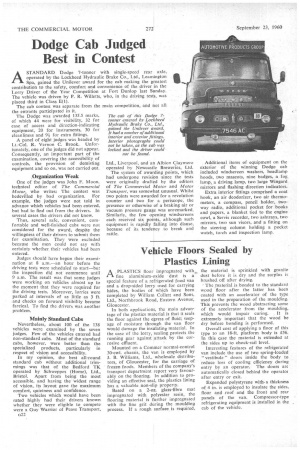Dodge Cab Judged Best in Contest
Page 140

If you've noticed an error in this article please click here to report it so we can fix it.
ASTANDARD Dodge 7-tanner with single-speed rear axle, operated by the Lockheed Hydraulic Brake Co., Ltd., Leamington Spa, gained the Unilever award for the cab making the greatest contribution to the safety, comfort and convenience of the driver in the Lorry Driver of the Year Competition at Fort Dunlop last Sunday. The vehicle was driven by P. R. Willetts, who, in the driving tests, was placed third in Class E(1).
The Dodge was awarded 135.5 marks, of which 44 were for visibility, 32 for ease of access and direction-indicating equipment, 20 for instruments, 30 for cleanliness and 91 for extra fittings.
A panel of eight judges was headed by Lt.-Col. R. Vernon C. Brook. Unfortunately, one of the judges did not appear. Consequently, an important part of the examination, covering the accessibility of controls, the provision of demisting equipment and so on, was not carried out.
Organization Weak One of the judges was John F. Moon, technical editor of Tire Commercial Motor, who writes: The contest was bedevilled by bad organization. For example, the judges were not told in advance which vehicles had been entered, but had to find out from the drivers. In several cases the drivers did not know.
Thus, several safe, convenient, comfortable and well-finished cabs were not considered for the award, despite the willingness of their drivers to submit them for examination. They were excluded because the men could not say with certainty whether their vehicles had been entered.
Judges should have begun their examination at 8 a.m.—an hour before the driving tests were scheduled to start—but the inspection did not commence until 9 a.m. The result was that some judges were working on vehicles almost up to the moment that they were required for the driving tests. Moreover, lorries were parked at intervals of as little as 3 ft. and checks on forward visibility became farcical. To find the drivers was another problem.
Mainly Standard Cabs
Nevertheless, about 100 of the 138 vehicles were examined by the seven judges. Few of the vehicles entered had non-standard cabs. Most of the standard cabs, however, were better than the specialized products, particularly in respect of vision and accessibility.
In my opinion, the best all-round standard cab without additional trimmings was that of the Bedford TK operated by Schweppes (Home), Ltd., Bristol. Apart from being the most accessible, and having the widest range of vision, its layout gave the maximum comfort, quietness and confidence.
Two vehicles which would have been rated highly had their drivers known whether they were eligible to compete were a Guy Warrior of Pease Transport, G22 Ltd., Liverpool, and an Albion Claymore operated by Newcastle Breweries, Ltd.
The system of awarding points, which had undergone revision since the tests were originally drafted by the editors of Tire Commercial Motor and Motor Transport, was somewhat unusual. Whilst two points were awarded for a revolution counter and two for a periscope, the presence or otherwise of a braking air or vacuum pressure gauge was unremarked. Similarly, the few opening windscreens each received six points, although such equipment is rapidly falling into disuse, because of its tendency to break and rattle.
Additional items of equipment on the exterior of the winning Dodge cab included windscreen washers, headlamp hoods, two mascots, nine badges, a fog lamp, a driving lamp, two large Wingard mirrors and flashing direction indicators.
Extra interior fittings comprised a coat hook, an air deodorizer, two air thermometers, a compass, pencil holder, twoway radio, additional pocket for books and papers, a blanket tied to the engine cowl, a Servis recorder, two ashtrays, two mirrors, two sun visors, and a fitting on the steering column holding a pocket watch, torch and inspection lamp.




































































































































































































































































































































































